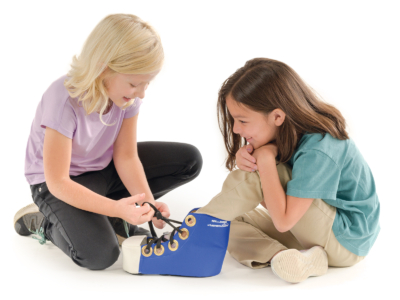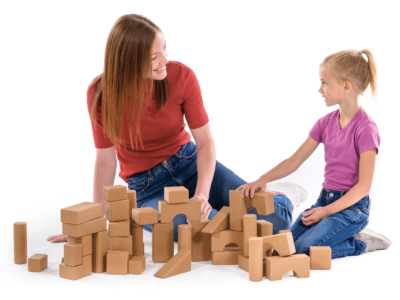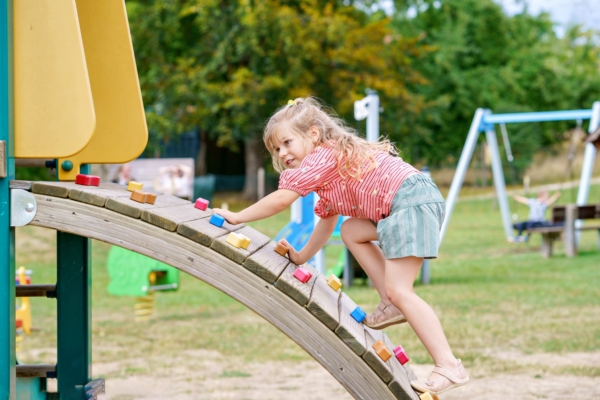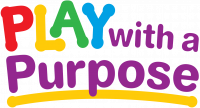Why can some 5-year-olds write their names with ease while others struggle to hold a pencil? The difference often comes down to whether the adults in their lives understand how play supports school readiness and early writing skills. When children climb, crawl, build, and create, both indoors and out, they are developing the strength, coordination, confidence, and skills they need to be successful in school and beyond.
Why School Readiness Starts with Play
We often think of “school readiness” in terms of recognizing letters and numbers, but true readiness extends much deeper. It’s about helping children develop the physical, emotional, and social foundations that enable learning. Before a child can sit and listen to a story, they need core strength and balance. Before they can focus in a classroom of 20 other children, they need practice managing emotions, following routines, and using their fingers with control.
This is where play comes in.
Play—especially the kind that involves movement, imagination, and hands-on exploration—builds the brain-body connections needed for academic success. Outdoor play builds gross motor strength, stamina, and the ability to self-regulate through physical exertion. Classroom play with blocks, manipulatives, and sensory materials hones fine motor skills, visual tracking, and problem-solving—all key to future reading and writing. Playing with tools like the Lace & Thread Library or Diversity Fastening Dolls helps children build dexterity, coordination, and finger strength—all essential for gripping and using a pencil.
When children lace, zip, button, and twist, they’re developing more than independence—they’re laying the groundwork for writing. These kinds of playful activities are deceptively powerful. They help children build the fine motor control, bilateral coordination, and focus required for handwriting, without ever picking up a worksheet.
By making space for play and choosing materials that support it, educators aren’t delaying academics. They’re setting children up for long-term success, starting with strong hands and confident hearts.
From Monkey Bars to Markers: The Play-Writing Connection
Writing doesn’t start with a pencil—it starts with movement. When children climb, swing, balance, and hang, they’re not just having fun—they’re building the upper body strength, core stability, and postural control needed to sit upright and maintain focus during writing tasks. A child who spends time navigating outdoor play structures is unknowingly preparing their body to support the fine motor work of writing.
We tend to focus on the fine motor needs for reading and writing, but the gross motor skills are just as important. The child has to have the strength, shoulder flexibility and eye tracking ability to hold the book up to read. The child develops the core strength through big body play, like running, swinging, and carrying heavy (for them) objects. They gain shoulder flexibility through climbing activities and whole arm movement like parachute play. Children work on their eye tracking through throwing and catching games. Without this type of play the child will struggle with early academic skills.
But it doesn’t stop at the playground.
Indoors, materials that invite threading, twisting, stacking, and squeezing—like the puzzles and blocks—help strengthen the small muscles in the hands and fingers. These activities also support bilateral coordination, visual tracking, and hand-eye coordination—all of which are essential for early writing development.
We discuss this topic frequently on the Childcare Conversations Podcast, particularly in our episode with Play with a Purpose, where we delve into the importance of selecting materials that not only entertain but also build readiness skills through meaningful play. (🎧 Listen to that episode here, or search “Play with a Purpose” on your favorite podcast platform.)
Whether inside or outside, the right kind of play helps children strengthen the foundation for writing—not just physically, but emotionally as well. When kids feel confident in their bodies and abilities, they’re more likely to take risks, try new tasks, and persist through challenges like learning to write their name.
- Gross motor play builds strength and stamina. When kids swing, climb, and balance, they’re not just having fun—they’re training their bodies to sit upright, focus attentively, and engage in classroom tasks without fatigue.
- Fine motor activities develop control and confidence. Threading laces, fastening closures, and manipulating pieces are essential building blocks for pencil grip and letter formation.
🎧 Listen to their insights here: Childcare Conversations: How Play-Based Learning Supports School Readiness — it’s a perfect complement to our discussion, reinforcing how playful materials and intentional spaces prepare children not just physically, but emotionally and cognitively, for the demands of early writing.
Instead of pushing paper-and-pencil tasks too early, early educators can set children up for success by embracing the power of purposeful play. When we make space for play, we’re not delaying learning—we’re preparing the soil so those academic skills can grow strong.
What Purposeful Play Looks Like
In one classroom, a group of preschoolers gathered around a low table filled with pegboards, threading toys, and chunky beads. While it may have looked like free play, the teacher knew exactly what was happening: those little hands were hard at work developing strength, control, and coordination. Over the next few weeks, several of the children who had previously resisted writing activities began picking up mark-making tools (pencils, crayons, paintbrushes) with more confidence and holding them with a functional grip. What had once been frustrating became a source of pride, simply because their fingers were ready for the task.
Across the hall, another group was exploring puzzles, stacking blocks, and opening and closing twist-top containers. These seemingly simple activities were building fine motor precision and bilateral coordination. One child who often avoided writing center time became a regular, choosing to “draw a story” each morning. The change didn’t come from extra worksheets—it came from play.
Outside, a climbing structure became the go-to space for a child who had struggled with attention during circle time. After several weeks of daily swinging, climbing, and carrying buckets of mulch across the yard, the child’s ability to sit still and attend during group activities improved noticeably. Big body play had helped strengthen the muscles that support posture and focus—making story time far more successful. The teachers noted that he also began using more language during transitions and was more willing to participate in small group activities.
When programs prepare their playgrounds with purpose, they create more opportunities for this kind of learning. The blog post “Prepare Your Childcare Playground for Summer” outlines simple ways to refresh outdoor spaces so children can move, explore, and build the physical foundations needed for academic tasks. From shaded quiet zones that encourage reflection and self-regulation to materials that promote lifting, digging, crawling, and balancing, small changes in the environment can lead to big developmental gains.
These are just a few examples, but they reflect a larger truth: when we design classrooms and playgrounds with intention, we give children what they truly need—space to grow strong, confident, and ready to write.
Making the Most of Play
The best thing we can do to support school readiness and early writing skills isn’t to push more worksheets—it’s to protect play. But not just any play. The kind that’s rich with purpose, variety, and opportunity.
Here are a few ways educators and program leaders can intentionally support writing readiness through play:
- Plan for movement and motor skill development every day.
Create time and space for both big body movement and fine motor practice. This means allowing time on the playground, but also making sure classrooms include activities like playdough, stacking, squeezing, and threading. Don’t assume every child will seek out these tasks—sometimes they need encouragement or a little modeling to dive in. - Rotate materials to keep play fresh and skill-building.
Add tools that challenge different muscles and coordination skills throughout the year. If you’ve had puzzles out for weeks, swap in something that requires different motions—like tweezers and pom-poms, hole punchers, or mini construction sets. Outdoors, consider adding digging tools, balance paths, or weighted buckets to build strength in creative ways. - Observe play with an eye toward growth.
Pay attention to how children interact with materials. Are they using both hands? Do they have control? Are they frustrated or focused? These moments offer insight into which skills are strengthening—and where extra support might be needed. Documentation isn’t just for assessments; it’s also a guide for choosing what to offer next. - Bridge play and academics with language.
Use playful language to support emerging academic skills. Instead of “Let’s work on our writing,” try “Let’s build strong writer hands today!” Encourage drawing, mark-making, storytelling, and pretend play as part of the writing journey—even if a pencil never touches paper that day.
The takeaway? Play isn’t a break from learning—it is learning. When we approach play with intention, we help children build the physical and emotional readiness needed for academic success, one joyful moment at a time.
If we want confident, capable writers in kindergarten and beyond, we have to start long before the handwriting lessons begin. It starts with the playground. It starts with puzzles and laces. It starts with intentional environments and adults who understand the power of purposeful play. When we protect and prioritize this kind of play, we’re not just preparing children for school—we’re preparing them for life.
Want to dive deeper into how play connects to school readiness, behavior, and classroom success? 🎧 Tune into the Childcare Conversations Podcast and check out our episode with Play with a Purpose. We share real stories, favorite materials, and practical tips to help you bring more learning through play into your program.









Leave A Comment